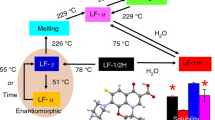Abstract
Rifapentine crystals with different habits were prepared by recrystallization from selected solvents, such as methanol, ethanol, chloroform, and acetic acid. Scanning electron microscopy, X-ray powder diffractometry, infrared spectrometry, and differential scanning calorimetry were used to investigate the physicochemical characteristics of the prepared crystals. The comparative dissolution behaviors of the newly developed crystals and of rifapentine without being treated were also studied. Results show that the newly developed crystals were different from each other with respect to physical properties but were identical chemically. Needle-shaped crystals were obtained from methanol, ethanol, and chloroform solvents, and the block-shaped crystals were obtained from acetic acid solvent. X-ray diffraction spectra and differential scanning calorimetry investigation on those developed crystals clearly indicate that rifapentine has different crystal structure modification. When the crystal was obtained from acetic acid, the change of crystal habit was originated from the crystal structure modification. The dissolution rate of newly developed crystals was found to be higher than that of rifapentine without being treated. However, the modified crystal obtained from acetic acid shows the lower dissolution rate than crystals obtained from other solvents.
Similar content being viewed by others
References
Kapoor A, Majumdar D K, Yadav, M R. Crystal forms of nimesulide-asulfonanilide (non-steriodal anti inflammatory drug). Indian J Chem, 1988, 37B: 572–575
Shekunov B Y, Grant D J W, Latham R J, Sherwood J N. In situ optical interferometric studies of the growth and dissolution behavior of paracetamol (acetaminophen) crystals. 3: Influence of growth in the presence of p-acetoxyacetanilide. J Phys Chem, 1997, B101: 9107–9112
Nokhodchi A, Bolourtchian N, Dinarvand R. Crystal modification of phenytoin using different solvents and crystallization conditions. Int J Pharm, 2003, 250: 85–97
Adhiyaman R, Basu S K. Crystal modification of dipyridamole using different solvents and crystallization conditions. Int J Pharm, 2006, 321: 27–34
Finnie S, Ristic R I, Sherwood J N, Zikic A M. Characterisation of growth behaviour of small paracetamol crystals grown from pure solutions. Chem Eng Res Design (Trans IChemE), 1996, A74: 835–838
Chen J X, Wang J K, Zhang Y, Wu H, Chen W, Guo Z C. Crystal growth, structure and morphology of hydrocortisone methanol solvate. J Crystal Growth, 2004, 265: 266–273
Prasad K V R, Ristic R I, Sheen D B, Sherwood J N. Crystallization of paracetamol from solution in the presence and absence of impurity. Int J Pharm, 2001, 215: 29–24
Chow A H L, Grant D J W. Modification of acetaminophen crystals. III: Influence of initial supersaturation during solution-phase growth on crystal properties in the presence and absence of p-acetoxyacetanilide. Int J Pharm, 1988, 42: 123–133
Zhou K, Li J, Ren Y S. Solubility of rifapentine in different organic solvents. J Chem Eng Data, 2008, 53: 998–999
Zhou K, Li J, Zheng D S. Solubility of rifapentine in the binary system of acetic acid and n-octanol solvent mixtures. J Chem Eng Data, 2008, 53: 1978–1979
Nie Q, Wang J K, Wang Y L, Bao Y. Effects of solvent and impurity on crystal habit Modification of 11α-Hydroxy-16α, 17α-epoxyprogesterone. Chin J Chem Eng, 2007, 15: 648–653
Hassan M A, Salem M S, Sueliman M S, Najib N M. Characterization of famotidine polymorphic forms. Int J Pharm, 1997, 149: 227–232
Dalton J T, Straughn A B, Dickason D A, Grandolfi G P. Predictive ability of level A in vitro-in vivo correlation for ringcap controlled-release acetaminophen tablets. Pharm Res, 2001, 18: 1729–1734
Author information
Authors and Affiliations
Corresponding author
Rights and permissions
About this article
Cite this article
Zhou, K., Li, J., Luo, J. et al. Crystal modification of rifapentine using different solvents. Front. Chem. Eng. China 4, 65–69 (2010). https://doi.org/10.1007/s11705-009-0302-6
Received:
Accepted:
Published:
Issue Date:
DOI: https://doi.org/10.1007/s11705-009-0302-6




